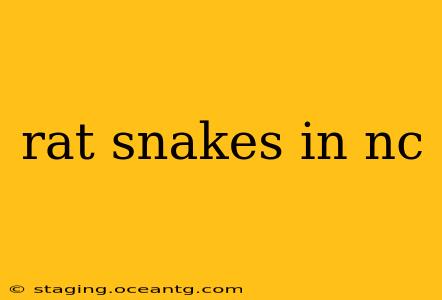North Carolina is home to a fascinating array of wildlife, and among its slithering inhabitants are several species of rat snakes. These non-venomous constrictors play a vital role in the ecosystem, controlling rodent populations and contributing to the state's biodiversity. This guide will delve into the world of NC rat snakes, exploring their identification, habitat, behavior, and the best practices for coexisting peacefully.
Identifying Rat Snakes in North Carolina
Several rat snake species call North Carolina home. Correct identification is crucial, particularly to avoid any unnecessary fear or harm to these beneficial reptiles. The most common are:
-
Eastern Ratsnake ( Pantherophis alleghaniensis): This is perhaps the most widely distributed rat snake in NC. They are typically grey or brown with darker blotches along their backs. They are often found in a variety of habitats, from forests to suburban areas.
-
Black Ratsnake ( Pantherophis obsoletus): As their name suggests, these snakes can be entirely black, or sometimes show some hints of brown or grey, particularly when young. They are larger and more robust than Eastern Ratsnakes and prefer wooded areas.
-
Corn Snake ( Pantherophis guttatus): While often kept as pets, corn snakes are also native to parts of North Carolina. They are characterized by their distinctive reddish-brown body with darker blotches and a lighter belly. Their natural habitats are usually drier areas like fields and rocky outcrops.
Key Identification Features: Look for smooth scales, large eyes, and a slender, cylindrical body. Avoid relying solely on color, as variations exist within each species. If unsure, consulting a herpetologist or using a reliable field guide is recommended.
What Eats Rat Snakes in NC?
Rat snakes, despite their size and strength, are not at the top of the food chain. Several predators in North Carolina prey on these snakes, including:
- Hawks: Red-tailed hawks and other raptors are known to hunt rat snakes.
- Owls: Great horned owls and other owl species are opportunistic predators.
- Larger Snakes: Other snakes, such as larger constrictors, may prey on younger or smaller rat snakes.
- Mammals: Raccoons, foxes, and even some larger domestic dogs may attack and kill rat snakes.
The specific predators vary depending on the habitat and the size of the rat snake.
Are Rat Snakes Poisonous/Venomous?
No, rat snakes in North Carolina are not venomous. They are constrictors, meaning they kill their prey by wrapping their bodies around it and squeezing until it suffocates. While they can deliver a painful bite if threatened, their bite is not venomous and requires no medical attention beyond cleaning the wound.
What Do Rat Snakes Eat?
Rat snakes, as their name suggests, have a diet primarily consisting of rodents. However, they are opportunistic feeders and may also consume:
- Birds: Eggs, nestlings, and occasionally adult birds.
- Other Reptiles: Lizards and smaller snakes.
- Amphibians: Frogs and toads.
- Insects: Large insects may be consumed opportunistically.
Their diet contributes significantly to pest control in both natural and human-altered environments.
How to Keep Rat Snakes Away from Your Home
While rat snakes are beneficial, encountering one in your home can be unsettling. Here are some tips to deter them:
- Seal entry points: Inspect your home for cracks and gaps in the foundation, walls, and roof, and seal them with caulk or other suitable materials.
- Remove attractants: Keep your yard clean, free of debris, and eliminate potential food sources such as rodent infestations. Properly store pet food and garbage.
- Remove cover: Reduce clutter and vegetation around your house, removing potential hiding places for snakes.
Remember, relocating a rat snake is often more effective than killing it. Contact your local wildlife agency or a licensed wildlife removal specialist for assistance.
What to Do if You See a Rat Snake in Your Home
If you encounter a rat snake in your home, remain calm and give the snake space. Do not attempt to handle it. Carefully guide the snake towards an exit point, such as an open door or window, if possible. Contact a wildlife professional if you are uncomfortable or unable to remove the snake yourself.
By understanding the behavior and needs of rat snakes, we can learn to coexist peacefully and appreciate their role in maintaining a healthy ecosystem. Remember, these are valuable creatures that contribute to our environment – let's strive for respectful co-existence.
